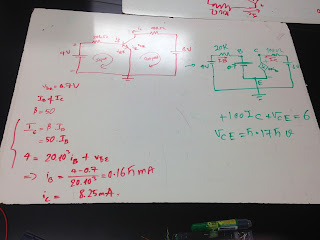Day 6: Notes MESH ANALYSIS and Transistors
Part 1: Quiz
The second quiz at the beginning of the class
The professor teaches the supermesh method to find for the current. Supermesh exists when two meshes have a current source in common. After that, we do one practice problem and use the supermesh method to solve.
the professor's instruction for the above problem
Part 2: Mesh Analysis Lab
This lab aims to help students understand the mesh analysis and apply its into real experiments. We will calculate the values
Pre-lab activity: calculate the V1 and I1 in the circuit using the mesh analysis. I1= 0.057mA, V1=5.02V.
A brief remind for the resistor code, then we need to get the right reistors
Our set-up to measure the voltage drop 6.8k Ohm, V1.
The calculation in green, and our measurement in red. V1. The actual resistance, consecutively, are 21.5k, 9.83k, 4.64k, and 6.65k (Ohm). According to this actual resistance, we get I1= 0.056mA, I2=-0.327mA, I3=1.079mA,and V1= 4.99V. The percent differences are %I1=1.79%, %V1=-0.04%. The percent difference between the measured value and our expectation is minuscule, our calculation agrees with our measurement.
We use everycircuit to check out calculation
Part 3: A BJT Curve Tracer Lab
Purpose: The lab introduces the properties of a BJT. Here is the NPN transitor (2N3904). We will learn about how a BJT performs, and what are base, collector, emitter terminals in a BJT, how the currents and voltages between these terminals relate.
Theory:
In order to help understanding more about BJT and its operation. I will introduce a lecture of BJT below.
We do a practice problem of BJT
Pre-lab: we set up the waveform generator as instructed in the lab manual. We will establish two waveform generators with different behaviors. We have, Vavg(1)=0.5V, Vavg(2)=1.5V, Vavg(3)=2.5V, Vavg(4)=3.5V, Vavg(5)=4.5V.
Assuming IB = (Vawg - V(BE)) / 100k , β = IC / IB , V(BE) = 0.7 v => IB(1)= 0, IB(2)=8uA, IB(3)=18uA, IB(4)=28uA, IB(5)=38uA.
Based on this circuit, we set-up the experiment. Note: for many people, including me at first. who do not know what channel 1 and 2 are used for, they are voltmeter reading the voltage drop.
Our set-up for this experiment
The oscilloscope of Ic and Vce. IC(1)=0, IC(2)=1.9mA, IC(3)=4mA, IC(4)=6mA, IC(5)=8mA
1. The current gain Beta (IC/IB) for each device.
B(1)= 0, B(2)= 238, B(3)= 222, B(4) = 214, B(5)= 210
2. The early voltage V(a)for its device based on the highest base current step.
| X0 | Y0 | X1 | Y1 | M | V(a) | B | B*V(a) | |
| 1 | 0 | 0 | 0 | 0 | 0 | 0 | 0 | 0 |
| 2 | 0.2 | 1.80E-03 | 4.6 | 2.00E-03 | 4.54545E-05 | 3.98E+01 | 237 | 9432.6 |
| 3 | 0.2 | 3.90E-03 | 4.5 | 4.00E-03 | 2.32558E-05 | 1.68E+02 | 222 | 37273.8 |
| 4 | 0.2 | 5.90E-03 | 4.3 | 6.10E-03 | 4.87805E-05 | 1.21E+02 | 214 | 25926.1 |
| 5 | 0.2 | 8.00E-03 | 4.2 | 8.20E-03 | 5E-05 | 1.60E+02 | 210 | 33642 |
The Early voltage ranges from 40 to 160 V. According to manufactor sepcification the early voltage also range from 100 -150V
The 2N3904 is a common NPN bipolar junction transistor used for general purpose low-power amplifying or switching applications.
Conclusion:
Today is really a long lecture and experiment. We study about supermesh and its application to simplify the equation system. We do a lab about the mesh analysis. The hardest part today would be about BJT. The BJT is kind of a complex experiment. We do research to understand how we analysis a BJT and follow the lab manual careful to get the expectation results.



























No comments:
Post a Comment